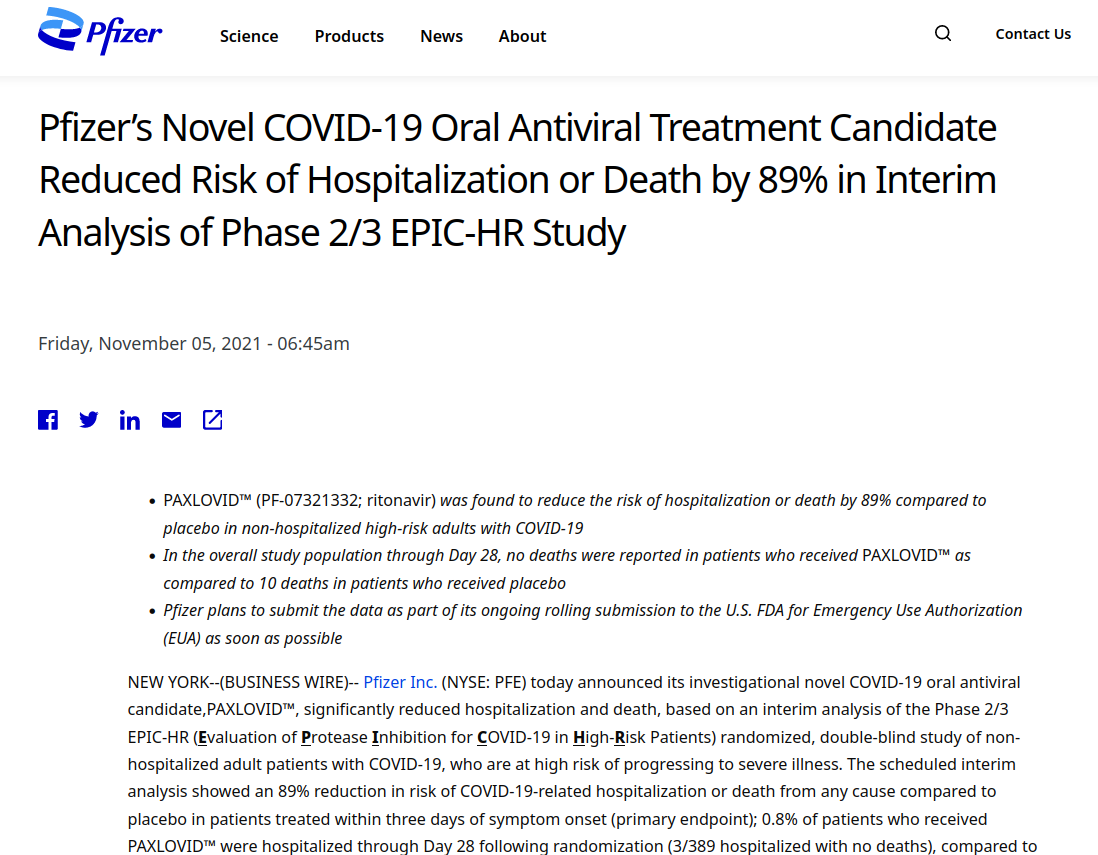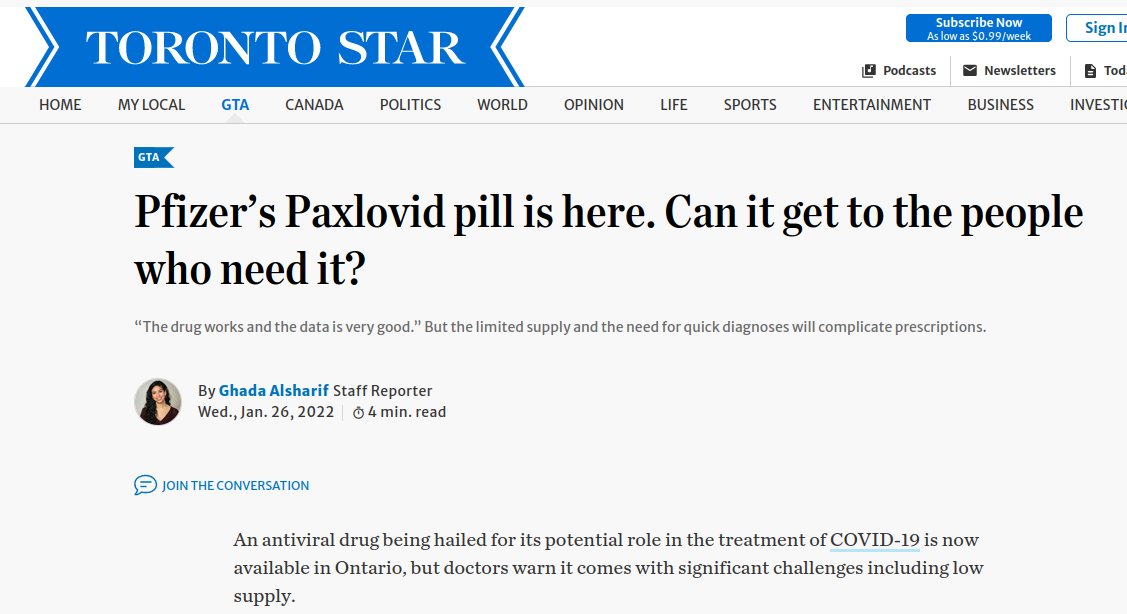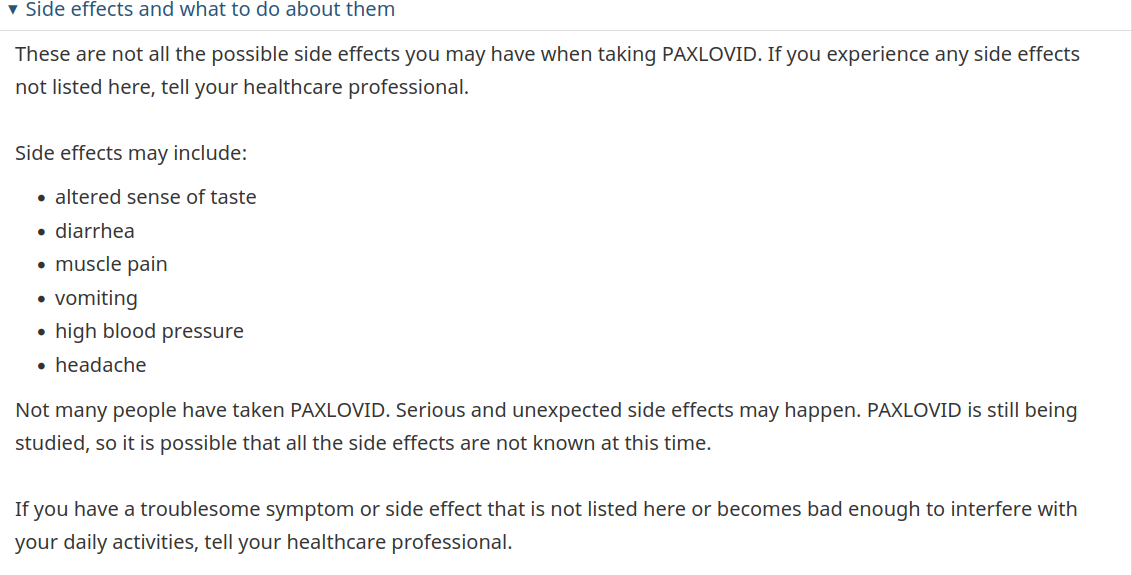The gigantic truck convoys are rolling toward Ottawa, accompanied by wall-to-wall supporters and media coverage.
At the same time though, Pfizer's Paxlovid is starting to be rolled out relatively quietly across North America, Europe, the U.K. and beyond.
It's a set of pills for Covid - and it's the second part of a one-two punch that started with the company's mRNA Covid shot. Together, they're powering Pfizer to dizzying levels of profit and market capitalization.
But there's little if any 'pax' (the Latin word for peace) likely to come from these pills. Paxlovid has been tested on very few people so far. It's not being studied at all on vaccinated people or those who've had Covid. The pills negatively interact with many very widely used medications. Plus of course the studies are being manipulated to produce seemingly good results.
I've heard that behind the scenes some regulatory-agency employees are sick and tired of yielding to intense pressure from politicians, public-health officials and and Big Pharma. They don't want members of the public to take this extremely poorly studied and potentially very dangerous set of pills.
Each dose of Paxlovid consists of one pill of ritonavir -- a repurposed old HIV drug -- and two pills of a new drug named nirmatrelvir. Both of these drugs are protease inhibitors.
This nirmatrelvir/ritonavir combo was authorized for use in the U.S. by the Food and Drug Administration under an Emergency Use Authorization (EUA) on Dec. 22, 2021, and for use in Canada by Health Canada on Jan. 17, 2022.
And it's rapidly being okayed elsewhere: for example, it got the nod in Israel on Dec. 26, 2021, South Korea on Dec. 27, 2021, the U.K. on Dec. 31, 2021, and France on Jan. 21, 2022.
It's allowed in youth -- 12 years of age and older -- and adults in the U.S., Israel and South Korea. In other countries including the U.K. and Canada it's authorized for people 18 years old and above.
(Note that authorization isn't approval; it's very rapid evaluation followed by the nod to let tens of millions of people take it, because supposedly we're in an unprecedented public-health crisis akin to a war.)
Also, a test in a petri dish by Pfizer scientists showed it may have some effect on Omicron -- see the first paragraph on page 36 of the Canadian Jan. 22 spec sheet (AKA product monograph) on it. Based on this very thin evidence, mainstream media are widely reporting that "the pills are expected to be effective against Omicron."
The nirmatrelvir/ritonavir pills are being authorized for use by people who test positive for Covid, have mild or moderate symptoms and are deemed to be 'at high risk for progression to severe COVID-19.'
But how does Pfizer define high risk?
Being 60 years of age or older. Or overweight. Or having high blood pressure. Or a number of other things - including having "other conditions or factors (i.e., race or ethnicity) that may place patients at high risk for progression." (See page 8 of the Canadian Jan. 22 spec sheet.)
That's an extremely broad definition.
Another alarming fact is that the U.S. and Canadian decisions to authorize nirmatrelvir/ritonavir were based only on interim analyses of an ongoing study. This trial started on Aug. 25, 2021, and is scheduled to finish on about April 24, 2022.
In total only approximately 1,000 people had been randomized to receive nirmatrelvir/ritonavir at the time U.S. and Canadian authorities gave it the thumbs up.
(It's very hard to decipher what the specific numbers are - both the Nov. 5, 2021, Pfizer news release describing the interim analysis examined by the FDA and the Jan. 17, 2022, Canadian product monograph -- which has an interim analysis from a slightly later date -- have a range of numbers, as well as several types of data analyses.)
Furthermore, only 13% of those small number were people 65 years of age or over, and just 3% were 75 and older. (See section 1.2, titled 'Geriatrics,' on page 4 of the Jan. 17, 2022, Canadian product monograph for Paxlovid.)
Plus, even those interim results were manipulated to the max in the study write-up (more on this below) - which in the case of the US was simply a Nov. 5, 2021, Pfizer news release.
And Pfizer didn't even make public the original data it supplied to Health Canada, as far as I can determine. Furthermore, the company's Jan. 17, 2022, news release announcing the authorization in Canada had very few details.
It was all very predictable.
That's obvious from the fact that more than a month before the FDA authorization -- on Nov. 18, 2021 -- the US government signed a $5.3-billion deal for 10 million courses of nirmatrelvir/ritonavir (i.e., $530 US per course), pending FDA authorization.
Ditto in Canada: on Dec. 3, 2021, the Canadian government announced its pledge to buy an initial one million courses of nirmatrelvir/ritonavir from Pfizer, pending Health Canada authorization. That is worth about $690 million (Canadian dollars) when you do the math based on $530 US per course. (A 'course' means the total number of doses needed to complete a treatment regimen.)
(The same announcement said the Canadian government also had signed an agreement with Merck to buy 500,000 courses of Merck's Covid pill molnupiravir -- with options for buying 500,000 more courses -- also pending Health Canada authorization.)(Molnupiravir was authorized by the US FDA a short time later, on Dec. 23, 2021, despite significant concerns. Those include its low effectiveness, high toxicity and potential for women who take it during pregnancy to give birth to children with birth defects. The FDA authorized Merck to sell it for people aged 18 or over with mild to moderate Covid who test positive and are at 'high risk' of developing severe Covid. Health Canada has not yet given it the nod. And media report that other countries also are getting cold feet about it.)
There's more. For example, nirmatrelvir/ritonavir hasn't been tested at all in people who haven't been vaccinated and/or haven't had Covid. Despite this, they are among the people that officials want first in line for it.
It also isn't being tested at all in pregnant or breastfeeding women.
Pfizer states on page 12 of the product monograph that Paxlovid "should not be used in pregnant women unless the potential benefits outweigh the potential risks to the fetus."
But there's no such warning for the use of nirmatrelvir/ritonavir by breastfeeding women.
As I noted earlier in this article, each dose of Paxlovid consists of two tablets of nirmaltrelvir and one tablet of ritonavir. Each set of three pills is to be taken twice a day for five days, starting within five days of symptom onset.
Ritonavir has been used since 1996 in people who test positive for HIV. It is widely known to cause serious, life-threatening conditions such as pancreatitis, heart-rhythm problems, liver problems, severe skin rash and allergic reactions.
Yet nirmatrelvir/ritonavir hasn't been studied in people with liver-function impairment. And neither Pfizer nor government officials are warning that nirmatrelvir/ritonavir should not be taken by, for example, people at risk of developing abnormal liver function (including those who have had hepatitis B, hepatitis C or elevated results on liver-function tests).
Instead, they're putting on the front lines the elderly, and those who live in poverty or are otherwise disadvantaged.
A Jan. 25 CBC News article reports that Canada's deputy chief public health officer, Howard Njoo, recommends the first in line for the pills should be "people who are immunocompromised, 80 years of age and over, or [those] who may not have access to health care because of geographical or socioeconomic concerns[,] are first in line -- regardless of vaccination status."
Quebec is one of the first places poised to start using it in these vulnerable people. By March they're expecting to receive enough of the pills to treat more than 25,000 people. That includes those with "serious conditions who cannot be vaccinated." After that, they'll open up the queue to others.
Therefore, it appears that politicians, government officials and Pfizer are stoking demand using the same playbook as they did with vaccines.
They're only making a relatively small number of pills available initially.
And the mainstream media are helping to hype it. For example one CBC report alone -- by Montreal journalist Verity Stevenson on Jan. 18 -- called it a "sought-after" drug that has been "lauded for its potential to reduce hospitalizations from the virus" via Pfizer's reporting "that Paxlovid reduced the risk of hospitalization or death by an impressive 89 per cent compared with a placebo."
And here's another example of the overall very positive coverage; it's in the Toronto Star today.
A Jan. 25, 2022, National Post article is somewhat of an exception: the author, Tom Blackwell, flags the problem of Paxlovid interfering with the effects of other medications (more on this below). However, he doesn't mention most of the other major drawbacks of the pills.
Yet even the Canadian federal government admits, on its web page for the general public on the pill, that "Not many people have taken Paxlovid. Serious and unexpected side effects may happen. Paxlovid is still being studied, so it is possible that all the side effects are not known at this time." [Bolding added by me.]
And further down on that same page it says that people should report any suspected side effects directly to Health Canada.
Unfortunately. however, we know from the scant reporting of serious effects and deaths from, for example, the Covid jabs, that it's highly unlikely the feds will faithfully tally and publicly display all such reports.
For its part, the FDA asked Pfizer to report to it "serious adverse events and all medication errors associated with the use of Paxlovid," as part of the EUA. It also stipulated that healthcare facilities and healthcare providers receiving Paxlovid will track and report serious adverse events and medication errors. However, this also is very unlikely to result in a full and honest public reporting.
(The FDA also asked the company to provide the FDA with further trial results relating to safety and effectiveness until the study concludes in April.)
So they're not even trying to pretend that it's been shown to be safe and effective.
After all, this is the pharmacocene epoch of our planet's history.
Here are three more red flags among the many surrounding Paxlovid:
- The US FDA omitted the important step of getting input from an advisory panel before giving an Emergency Use Authorization to Paxlovid.
(In contrast, in the case of molnupiravir it was convened, at the end of November, 2021 [the members voted for it, 13 to 10, and on Dec. 23, 2021, the FDA authorized it].)
I found this out when I stumbled on a Jan. 6, 2022, SonsOfLibertyMedia.com article on Paxlovid. The article describes, among many other insightful information, this Dec. 22, 2021, Bloomberg Law article on the controversy caused by the FDA skipping this important step.
The panel meetings usually are just a rubber stamp, but nonetheless skipping it is very unusual.
- In addition to being a protease inhibitor, ritonavir reduces the activity of a very important enzyme called CYP3A4. CYP3A4 is produced in the liver. There, it's central to metabolizing (i.e., breaking down) a large number of drugs and toxins; this is a necessary before the drugs and toxins can be cleared from the body.
The Canadian federal-government website on Paxlovid admits that "many medicines interact with Paxlovid. Taking Paxlovid with these medicines may cause serious or life-threatening side effects." [Bolding added by me.]
In total, there are more than 100 medications that Pfizer says shouldn't be taken with Paxlovid. They include very widely used ones like lidocaine, warfarin, phenobarbital, erythromycin, St. John's wort, fentanyl, methadone, midazolam and prednisone.
- The study results in the Pfizer US Nov. 5, 2021, press release relied on 'intent-to-treat' statistical analyses. These are not at all rigorous.
And just to be clear, the Pfizer news-release study didn't stop there - its intent-to-treat analyses use a 'modified' approach. Specifically they include, for example, people "who at baseline did not receive nor were expected to received COVID-19 therapeutic mAb [monoclonal antibody] treatment."'
You can't make this stuff up.
I sincerely hope that the employees who behind the scenes are pushing back against the pressure to let Paxlovid be given to many people will win the day.
---------
About: After obtaining an MSc in molecular biology from the Faculty of Medicine at the University of Calgary, Rosemary Frei became a freelance writer. For the next 22 years she was a medical writer and journalist. She pivoted again in early 2016 to full-time, independent activism and investigative journalism. Her website is RosemaryFrei.ca.







Reader Comments
[Link]
RC
The Truckers are patient souls
Lying FUCK
[Link]
Lying FUCK
ATTA GIRL
[Link]
Hydrogen peroxide doesn't work for all cancers. My mom had leukemia, she tried it and it didn't work. It could work for other cancers. Anyone who gets cancer should try everything under the sun and never give up.
[Link]
Here’s Bourla again failing to control his human shape. His neck looks like of a toad
[Link]
Graphene oxide and microtechnology confirmed in Cansino, Pfizer, Sinopharm, AstraZeneca, and Sputnik vaccination vials
JANUARY 27, 2022
[Link]
JANUARY 28, 2022
[Link]
be sure, that in few time, you will be GOLEMS controlled by Joysticks from any House
🐒 does as monkey says.
[Link]
[Link]
[Link]
This "features an interview with Christine Massey. She will discuss how she used Freedom of Information requests to ask for proof of virus isolation from many "health" organizations like the CDC. What she found may (or may not) surprise you. I hope you'll tune in and share this important information with your loved ones." [Link]
[Link]
Do you have a blockage in your artery, that could be causing high blood pressure? You need to get the blockage cleaned out. The stupid doctors will only prescribe toxic drugs that will cause side effects and the person will end up being prescribed another drug to treat the never ending side effects from all toxic drugs. Big Pharma loves this cycle of never ending side effects from their products; this keeps their bank accounts happy. Look into EDTA chelation. You can do it at home with a liquid EDTA, it takes about 6 weeks. Or, you can have it done by a naturopath but the IV treatments are expensive.
'Who Had Their Finger on the Magic of Life - Antoine BeChamp or Louis Pasteur?' [Link]
Thought you might enjoy this tooAmandaMay
Gorgeous music, thanks pzv + HVAC Tech [Link]
[Link]
[Link]
[Link]
[Link]
Sleep + Dr Mercola
[Link]
(Around 7 or 8 min mark)
[Link]
[Link]
[Link]
[Link]
CHAGA Tea 5 cups daily
1 daily cup of SauerKraut,
💋
These gals are excellent and detailed but also like to yak.
[Link]
[Link]
We have finally entered a NEW REALITY Folks YasYasYass 🥳🥳
FREE Astrology Academy
Stormie Grace
[Link]
Louie PASTEUR’s deathbed words: “Bernard was right; the pathogen is nothing; the terrain is everything.” [Link]
Before I began, went from sad [Link]
To glad... [Link] & [Link]
Can you believe it over 7 1/2 Billion views?? [Link] Gotta go to where the weather is warmer !
.h.a.p.p.y.
Congrats on your job, I look forward to starting work again and music always helps more than any medicine out there.. I'm partial to One Republic myself. I do a lot of research but I hear you about concentrating on lengthy links; I skimm thru myself because there is so much content and most of it I have heard already.
I do hear about the side effects of meds as well and am worried about it and that is why after three months I shall wean myself off of these ones. [Link] My link is with some of my fave music. Hope you enjoy.
[Link]
All that is seen at this
Premier Kenney says vote to lift vaccine mandate coming early next week
Alberta will move toward lifting COVID-19 restrictions early next week, starting with the Restrictions Exemptions Program and measures involving children, Premier Jason Kenney said Thursday. The...The heads of this mess need to roll, I think we both agree on that bit.